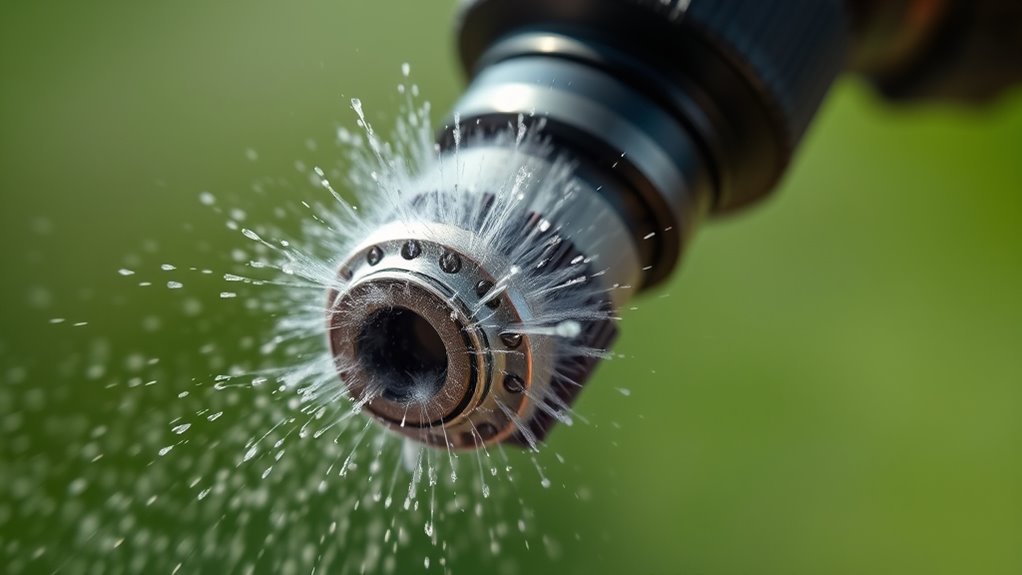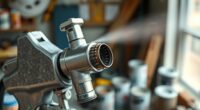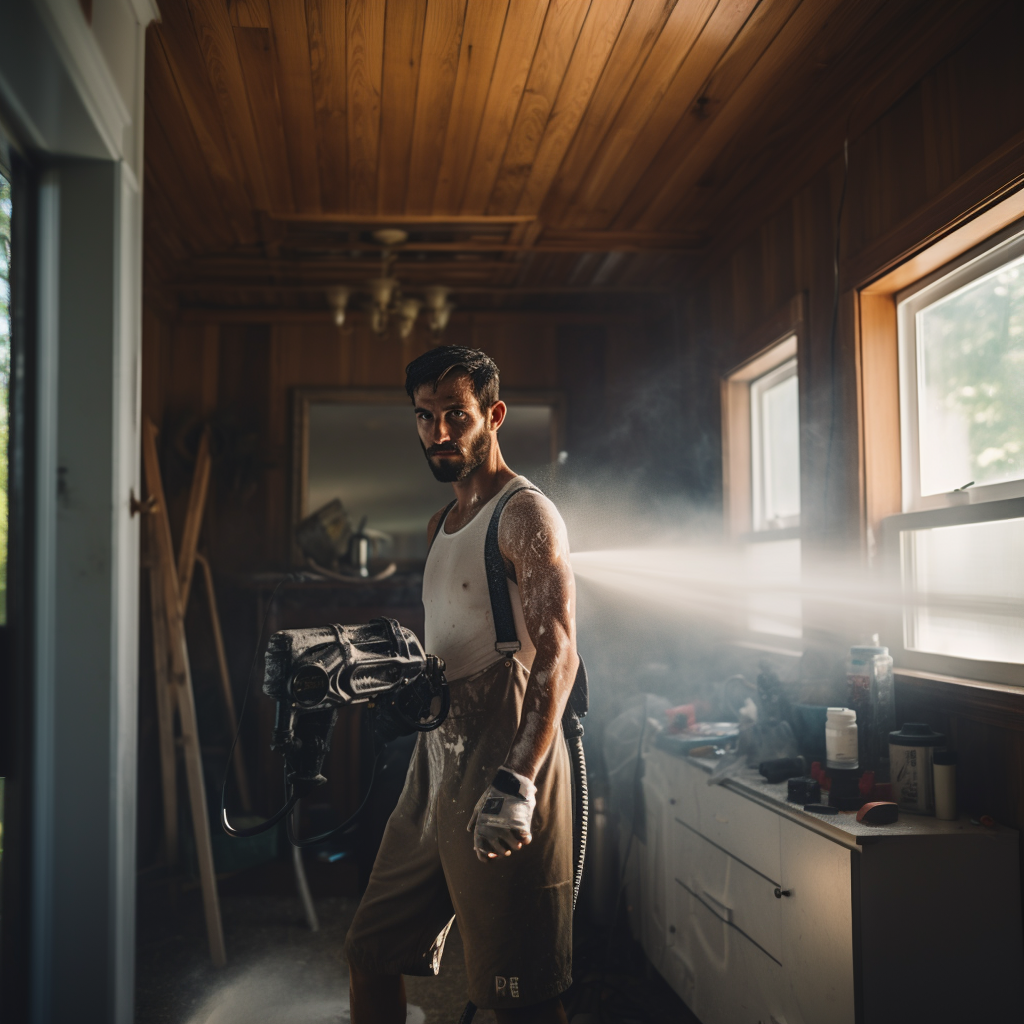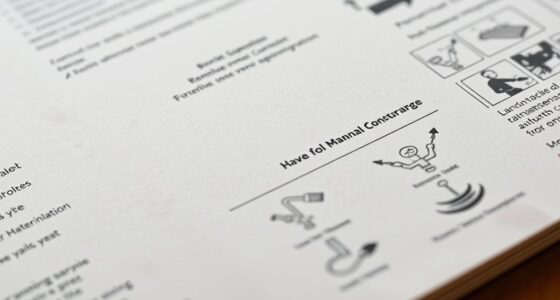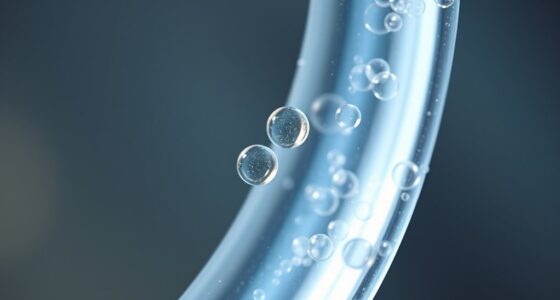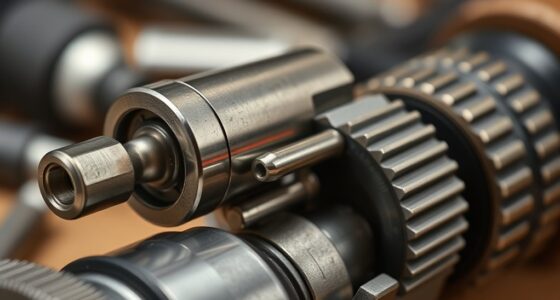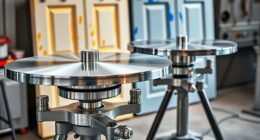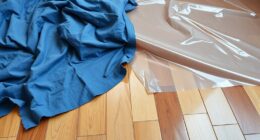To diagnose uneven spray patterns, start by inspecting the nozzle and spray tips for blockages, damage, or debris that could disrupt flow. Check the pressure levels and listen for pump irregularities, ensuring consistent pressure. Examine the fluid delivery system for leaks, clogs, or cracks that might cause uneven distribution. Regular maintenance, proper calibration, and replacement of worn parts can restore a smooth, even spray—continue to explore these steps to perfect your technique.
Key Takeaways
- Inspect and clean the nozzle for debris, clogs, or damage to ensure proper spray flow.
- Check for pressure fluctuations or pump issues that may cause inconsistent spray patterns.
- Examine the fluid delivery system, including hoses and filters, for obstructions or leaks.
- Verify spray angle and nozzle alignment, replacing worn or damaged nozzles as needed.
- Perform routine calibration and maintenance to maintain uniform spray distribution.
Identifying Common Symptoms of Uneven Spray Patterns
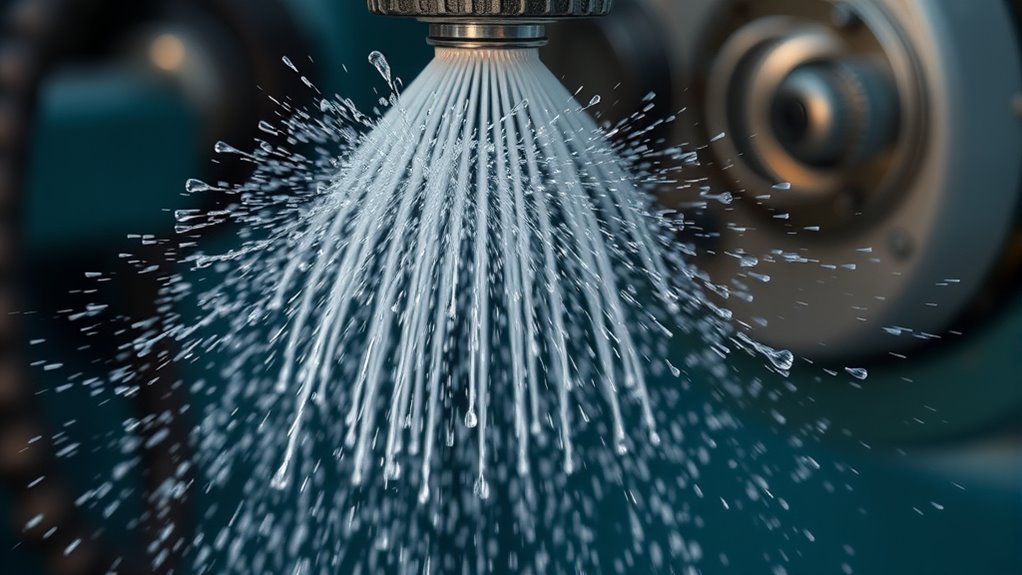
Uneven spray patterns often manifest through noticeable inconsistencies in the application process. You might notice areas where the paint or coating is thicker or thinner than desired, indicating poor spray pattern consistency. Drips, runs, or uneven coverage are common signs that something’s off. If your spray pattern is inconsistent, it could be a sign of nozzle wear, which affects how the fluid disperses. Over time, nozzles can become worn or damaged, disrupting the uniformity of the spray. You may also see splattering or uneven cloud shapes, further signaling irregularities. Recognizing these symptoms early helps you address issues before they worsen, ensuring a smoother, more professional finish. Regular nozzle maintenance and cleaning can prevent wear and tear, maintaining optimal spray performance. Paying attention to nozzle condition is essential for consistent results, as worn nozzles directly impact spray quality. Ensuring proper equipment calibration can also help achieve more uniform application and extend the lifespan of your spray tools. Additionally, using the correct pressure settings ensures the spray pattern remains even across different surfaces. Properly selecting the right nozzle type based on your project needs can significantly improve spray consistency. Keep an eye out for these signs to maintain ideal spray performance.
Inspecting the Nozzle and Spray Tips for Blockages
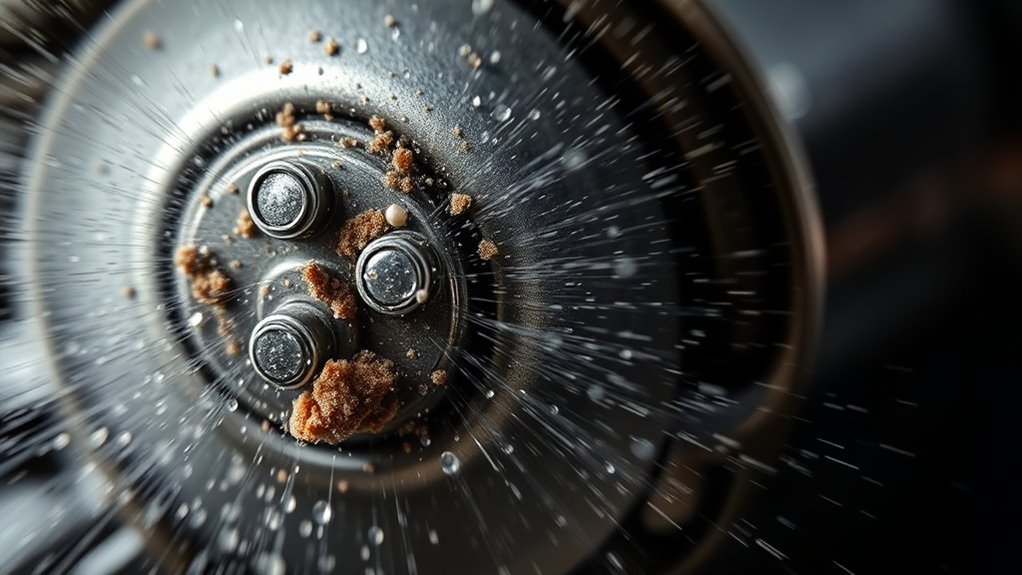
When you notice inconsistent spray patterns, inspecting the nozzle and spray tips is a logical first step. Remove the nozzle and examine the spray tip for dirt, debris, or buildup that could cause blockages. Clean the nozzle thoroughly with water or a soft brush to restore proper flow. Check the spray angle—if it’s irregular or narrow, it might indicate partial blockage or misalignment. Proper nozzle calibration ensures the spray pattern matches the intended coverage, so verify that your nozzles are correctly calibrated. Look for damage or cracks in the spray tips, as these can also affect spray uniformity. Clear blockages and ensure the nozzle is clean and correctly calibrated to restore an even, consistent spray pattern. Regular maintenance of spray tips helps maintain optimal performance and prolongs the lifespan of your equipment, especially when you pay attention to nozzle maintenance and cleanliness. Additionally, inspecting for signs of wear can prevent unexpected failures and ensure consistent spray quality over time. Incorporating tuning techniques from related fields, such as vehicle performance upgrades, can also help optimize spray system operation and reliability.
Checking for Pressure Fluctuations and Pump Issues
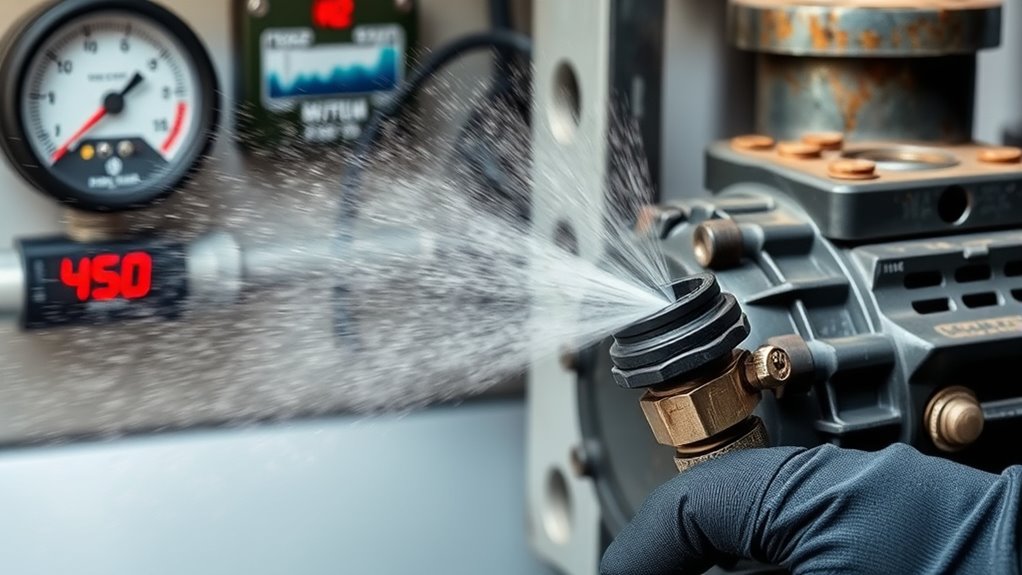
Pressure fluctuations and pump issues often cause inconsistent spray patterns, making it essential to monitor your system’s pressure regularly. Start by checking the pressure gauge; fluctuations indicate pressure drops or surges. Listen for unusual pump noise—grinding, knocking, or irregular sounds can signal problems. Ensure the pump is running smoothly and consistently. Look for leaks or blockages in hoses that might affect pressure. Also, verify that the pressure regulator is set correctly and functioning properly. Additionally, inspecting the pressure relief valve can prevent over-pressurization that affects spray quality. Regularly inspecting these elements helps maintain even spray patterns and prevents uneven application. Proper filtration and pump protection can also help avoid debris buildup that causes pressure instability. Additionally, being aware of AI security concerns can help prevent system vulnerabilities that might affect equipment performance. Incorporating routine maintenance can also detect early signs of pump or pressure issues before they cause significant problems. Paying attention to pressure stability is key to ensuring consistent spray distribution over time.
Examining the Fluid Delivery System for Obstructions or Damage
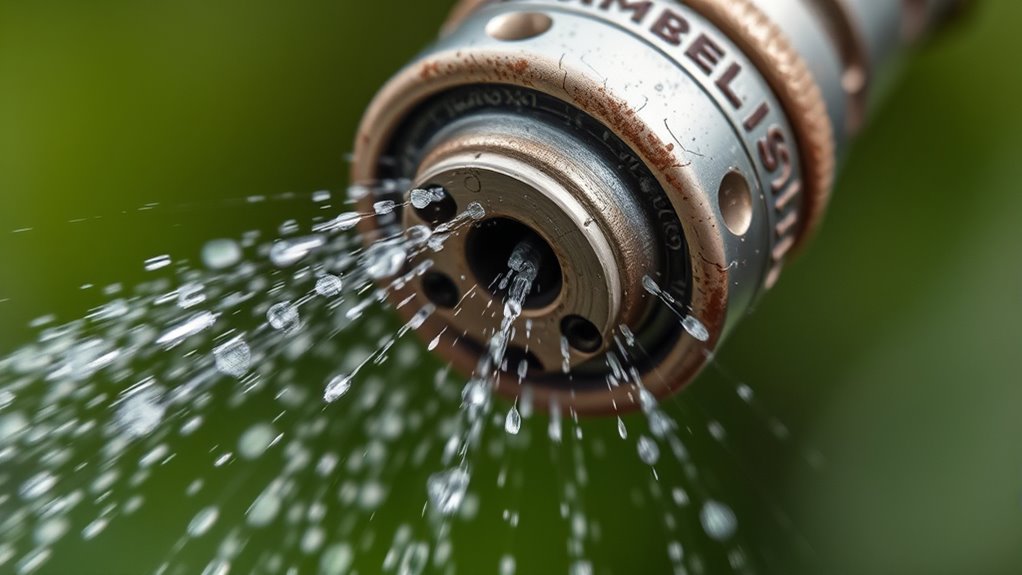
To guarantee consistent spray patterns, you should inspect the fluid delivery system for any obstructions or damage. Begin by examining the fluid pathway for clogs, debris, or buildup that could restrict flow. Check all delivery components, such as nozzles, filters, and hoses, for cracks, leaks, or blockages. Remove and clean any parts that appear dirty or clogged, ensuring the flow remains unobstructed. Pay close attention to small passages or screens where debris can easily accumulate. Damaged or worn delivery components can cause uneven spray, so replace any cracked nozzles or compromised hoses. Regular inspection of these parts helps maintain proper fluid flow, preventing uneven distribution and ensuring your equipment functions efficiently. Understanding the importance of proper maintenance can help prolong the lifespan of your equipment and ensure optimal performance. Incorporating routine checks inspired by electric dirt bike maintenance practices can also help identify potential issues early, especially since local resources for repair and replacement parts are vital for timely fixes.
Performing Maintenance and Adjustments to Restore Even Spray Distribution

Regular maintenance and precise adjustments are essential for restoring even spray distribution. Start by checking your spray pattern calibration; make sure the nozzles are aligned correctly and functioning properly. If the spray remains uneven, consider replacing worn or damaged nozzles to guarantee consistent flow. Adjust the pressure settings if needed, as improper pressure can cause irregular spray patterns. Clean the nozzles thoroughly to remove any buildup that could block or distort spray. Regularly inspecting and maintaining these components keeps your system running smoothly. Additionally, monitoring the nozzle performance helps identify issues early before they affect spray quality. Ensuring that your equipment follows manufacturer guidelines can also prevent irregular spray patterns from developing over time. Maintaining proper equipment calibration is also crucial to prevent further inconsistencies and ensure optimal operation. Incorporating routine system checks can further help in early detection of potential problems.
Frequently Asked Questions
Can Environmental Factors Affect Spray Pattern Consistency?
Environmental factors definitely influence your spray pattern consistency. Humidity effects can cause your spray to be uneven, as moisture levels impact how the liquid disperses. Wind influence is also significant; strong breezes can push or distort your spray, leading to inconsistent coverage. To get the best results, try spraying in calm, dry conditions, and monitor the weather to avoid issues caused by these environmental factors.
How Do Temperature Changes Influence Spray Performance?
Imagine your spray pattern as a delicate dance, where temperature fluctuation can trip up the rhythm. As temperatures rise or drop, spray viscosity changes, making the fluid thicker or thinner. This affects how smoothly your spray flows, causing uneven coverage or clogs. When temperatures swing wildly, your spray performance suffers, leading to inconsistent results. Keeping temperatures steady helps your spray glide perfectly, ensuring even, flawless coverage every time.
Are There Specific Nozzle Types Better for Certain Applications?
When choosing nozzles, you should consider application-specific nozzles made from suitable materials. For example, stainless steel nozzles work well for harsh chemicals, while plastic ones suit lighter fluids. Different nozzle types optimize spray patterns and flow rates for your needs. Matching nozzle materials and types to your application guarantees better performance, reduces wear, and extends lifespan. Always select nozzles designed specifically for your task to achieve the best results.
What Safety Precautions Should Be Taken During Maintenance?
Think of maintenance like handling fragile glass—you need to be cautious. Always wear personal protective equipment, such as gloves and goggles, to prevent injuries. Follow proper procedures for safe handling of chemicals and parts, and disconnect equipment from power sources before working on it. Prioritize safety at all times, because rushing can lead to accidents, just like rushing to grab that glass shard can cause cuts. Safety first keeps everyone protected.
How Often Should Spray Systems Be Calibrated for Optimal Performance?
For ideal performance, you should calibrate your spray system regularly, typically based on your maintenance scheduling. Calibration frequency depends on usage intensity and environmental factors but generally should be done at least once a season or every few months. Keep track of calibration dates to maintain accuracy. Regular calibration ensures your spray pattern remains even, saving resources and improving application effectiveness over time.
Conclusion
Think of diagnosing and fixing uneven spray patterns like tuning a musical instrument. When each part works in harmony, your spray flows smoothly and accurately. By inspecting nozzles, checking pressure, and maintaining your system, you’re fine-tuning your equipment for perfect performance. With a little attention and care, you’ll transform a messy, discordant spray into a well-orchestrated display that hits the mark every time. Keep your system in harmony, and your results will sing.
Franz came aboard the Paint Sprayer Zone team with a background in both journalism and home renovation. His articulate writing style, combined with a passion for DIY projects, makes him an invaluable asset. Franz has a knack for breaking down technical jargon into easy-to-understand content, ensuring that even the most novice of readers can grasp the complexities of paint sprayers.
